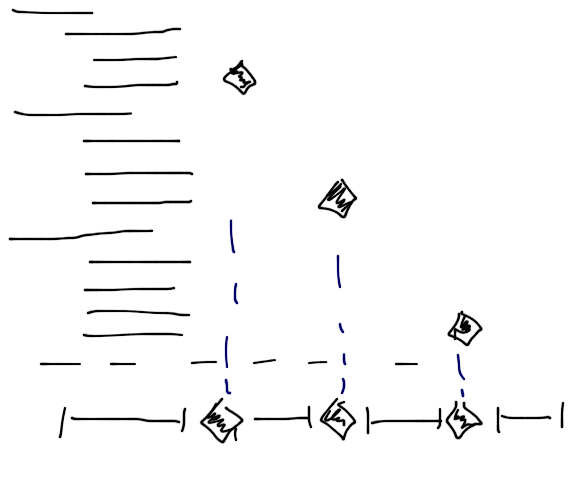Depending on the organizational level from which you are looking at a project the tendency is to focus either on solving the problem directly or escalating the lack of a solution to that problem.
People directly involved in a project tend to focus on seeking solutions and resort to escalations when it’s late.
Those from middle or top management are more prone to escalate early — most likely because they lack details or specialist knowledge to understand the nature of the problem.
One way to invest in one’s future is by setting up hooks — future launching pads for career changes. This is particularly advisable when there are relatively few personal and professional obligations in our lives, i.e. one can stay up late investing in a community, leave home on a Socrates program, invest long-term in interesting, passionate relationships, or write articles in the night or early mornings without sacrificing family time, time you’d normally spend with your significant other, doing homework with the kids or teaching them something otherwise.
This pays back later on, when there is less space for a running start.
 There is a saying “those who want look for means, those who do not — seek for reasons”. It’s easy to say “I have no time.” I do this myself far too often. With a growing family and new demands for my time — privately and professionally — explanations are readily at hand.
There is a saying “those who want look for means, those who do not — seek for reasons”. It’s easy to say “I have no time.” I do this myself far too often. With a growing family and new demands for my time — privately and professionally — explanations are readily at hand.
Time, however, is not a resource. Time does not wait. You cannot store time either. “Saving time” is a figure of speech. As anyone or anything on our planet we are submerged in time, and it is our decisions that define whether we use this time well or not.
Efficiency for its own sake is a recipe for disaster — something I’m becoming more aware of in nowadays corporations competing on the global market. “Efficiency” is just the means. The “why” is more important.
We can become extremely efficient at doing the wrong things. Or forgetting what is truly important.
… built a house from scratch, became a father for the 3rd time, finished my PRINCE2 Practitioner. Now it’s time to get back to work.
I was talking with my Colleague about Seth Godin and bam! the first article I see rings true like a church bell to me – A productivity gap:
You’d think that with all the iPad productivity apps, smartphone productivity apps, productivity blogs and techniques and discussions… that we’d be more productive as a result.
[…]
Isaac Asimov wrote more than 400 books, on a manual typewriter, with no access to modern productivity tools. I find it hard to imagine they would have helped him write 400 more.
Productivity has nothing to do with all of the fancy tools out there. Of course, that’s my opinion, and my opinion only. And believe me, I “invented” lots and lots of tool-related problems in order to waste time solving them later on. If anything, tools *might* draw us further from being creative as we begin to focus more on the process rather than the outcome itself – perfecting the *how* instead of shipping something worthwhile. We don’t need much in order to do good. The flip-side – the more we complicate our lives, the less space remains to fill it with value.
Reference: http://sethgodin.typepad.com/seths_blog/2013/12/a-productivity-gap.html
PRINCE2 distinguishes between management and technical, specialist products. The first are “value enablers,” the latter drive the real value for the customer. Both are needed — assuming the right balance, but it is technical products that build the project’s backbone.

There are companies where extensive control processes diminish the clarity of the value for the customer. The key aspect then is the organization’s project lifecycle — its phases determine the key dates for the project.
In such organizations milestone plans — the ones based on key technical deliverables (groups of deliverables) — are a rare thing to find.
Lesson learned
When developing the scope, building a WBS, and later on — continuing with a schedule, we should still create a milestone plan, presenting the completion of key technical products (not project lifecycle phase gates). Such a plan is particularly useful when reporting progress and when discussing the project with the organization’s management.

One of my favorite quotes is Woody Allen’s famous:
> 80 percent of life (success) is showing up.
According to the author, success lies behind making an attempt.
But even when we feel overwhelmed, when we consider giving up, if we do show up, we find ourselves doing our best anyway (provided we have decent work ethics). To be there is often enough. In many ways.
“A formidable person is one who seems like they’ll get what they want, regardless of whatever obstacles are in the way.” – Paul Graham
A formidable organization is one that limits the creation of internal obstacles.
Editor’s note (2013-08-11):
It occured to me that limiting the creation of internal obstacles is rather good enough. To be truly formidable, an organization would need to actively seek for ways to reduce the number of such obstacles.
I got fooled. I tought there was no limit to efficiency. I was wrong. And it’s not simply the inability to do faster or more things at once. You can process things faster, to some extent. You can do more, but only to a certain degree. There is a price in the long run and that is something we tend to ignore. When dealing with people, pushing the effectiveness bar too far and overloading the employee might influence the atmosphere at work, result in burn-out, and generally — decrease job satisfaction.
Every knowledge work needs introspection — the time & space to…
- Incorporate new knowledge
- Build on latest experiences
- Link between different domains
- Gain strength to improve further
Routine helps greatly. It creates space. But most important is to simply allow time. To limit work in progress. To allow play.
Many words have been written & said about the “myth of 100% effectiveness.” I have learnt my own share and cannot stress how destructive this kind of belief is. While adding to the burden helps improving one’s tools and processes to some extent, it destroys too much to be justified in the long run.

 There is a saying “those who want look for means, those who do not — seek for reasons”. It’s easy to say “I have no time.” I do this myself far too often. With a growing family and new demands for my time — privately and professionally — explanations are readily at hand.
There is a saying “those who want look for means, those who do not — seek for reasons”. It’s easy to say “I have no time.” I do this myself far too often. With a growing family and new demands for my time — privately and professionally — explanations are readily at hand.
